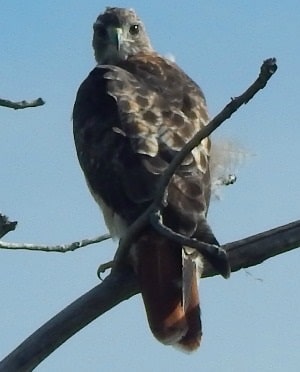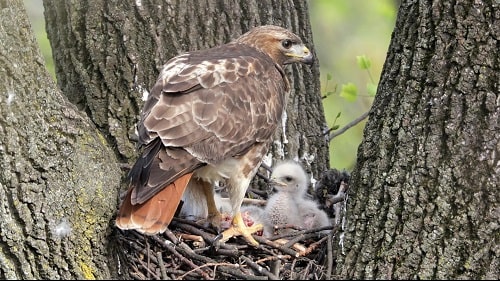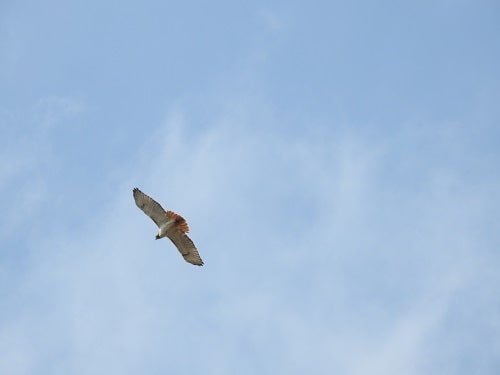The Red-tailed Hawk: Mating and Nesting Guide
One of the most common birds of prey, this raptor will nest throughout North America in a variety of open habitats.
Begins nesting mid-March and raises one brood per season
Hovers, motionless against the wind, while searching for prey.
Appearance: Size, Plumage Male Female Difference

A large bird, the Red-tailed Hawk, measures 19 to 26 inches in length with a wingspan of 4 1/2 feet. The female is up to a third larger than the male.
The plumage of these birds varies depending on the region in which it resides.
Typically, the adult bird is a dark brown above with a white breast and a band across the belly.
The tail is brick red on the upper side.
Immature Red-tails are similar in appearance, except the tail is brown, turning reddish the following spring.
Mating - Breeding Season Attracting Mates
The mating and breeding habits of these birds begin at about three years of age and include aerial displays meant to advertise their readiness for breeding and nesting.

The Red-tailed hawk's courtship begins in late winter to early spring. During this time, the male red-tailed hawk will perform a courtship display to attract a female mate.
The male's courtship ritual begins with him flying high in the air and then diving rapidly, often spiraling and performing other acrobatic maneuvers to impress the female.
The male will also bring the female gifts of food, such as small mammals or birds, as partof the rituals to court her.
Once a pair has formed, they will engage in mutual preening and vocalizations to strengthen their bond.
Eventually, they will mate, which typically involves the male climbing on top of the female and briefly copulating.
The breeding season of Red-tailed hawks begins between March and April.
Do Red-tailed Hawks Mate for Life
Red-tailed hawks are monogamous birds, remaining with the same mate throughout the breeding season, often mating for life.
Male and female will stay in the same nesting territory every year, even using the same nest.
In the event one dies, the remaining one will quickly seek out a new mate.
Nesting Habits - Season
The Red-tailed hawk's nest is built by both male and female birds.
The hawk nest is a platform constructed of sticks and twigs, lined with bark and greenery.
Nest-building season may begin in February with established pairs from previous seasons, with the first egg being laid by mid-March.
Old nests are reused with some refurbishing by adding sticks and greenery.
The nest is located in a tree 15 to 120 feet above the ground. Sometimes nests are built on cliffs.
Egg Laying, Incubation, Leaving Nest
The female Red-tailed hawk begins laying eggs as early as mid-March.
She lays one egg every other day until a clutch of 1 to 4 bluish-white eggs with dark marks is complete. Most commonly lays 2 to 3 eggs.
Incubation begins after the first egg is laid. The eggs hatch over several days.
The male and female share incubation duties with the female incubating longer times. The eggs hatch after 28 days of incubation.
The young red-tails will leave the nest in 44 to 46 days after hatching.
| Red-tailed Hawk Nesting Timeline | |
|---|---|
| Eggs | 1 - 4 / 2 - 3 most common |
| Incubation | 28 days |
| Nestling Phase | 44 - 46 days |
| Broods | 1 |
Red-tailed hawks raise only one brood per nesting season. They may re-nest if the first attempt is unsuccessful.
Red-tailed Hawks are very territorial towards others of their species. Sometimes locking talons in flight with intruders.

Feeding Habits: Diet
In the nest, the male feeds both the female and the young. Occasionally, the female may make short hunting trips.
Highly valued by farmers, the Red-tailed Hawk may perch, hover, or hold still into the wind when hunting.
While Red-tailed Hawks will eat mice, birds, large insects, reptiles, and other small mammals, it's rats, voles, and hares that make up the bulk of their diet.
Most of their hunting (60 - 80 percent) is done while perched. The eyesight of a Red-tailed Hawk is about eight times stronger than humans.
Red-tailed Hawk Call and Meanings
Scream: The most iconic call of the red-tailed hawk is its high-pitched scream, often portrayed in movies and TV shows to represent eagles or hawks.
This call is a series of descending, raspy screams that can carry over long distances.
It's often used for territorial communication and attracting mates.
Kee-eee-arr: This call is a bit more melodic than the scream.
It consists of a series of repeated notes, starting with a high "kee" followed by a descending "eee-arr."
This call is also used for territorial communication and is often heard during the breeding season.
Migration
Only the northern populations of the Red-tailed Hawk (Alaska, Canada, northern United States) migrate south in winter. Others are non-migratory.
Lifespan: How Long Do They Live
The Red-tailed Hawks average lifespan in the wild ranges from 13 to 20 years. In captivity, lifespans are usually longer. The most commonly caught for falconry in the United States.
What to Do When You Find Hawks At Your Feeders
Frequently Asked Questions
Are They Rare?
Probably the most common of the raptors, Red-tails have expanded into Eastern North America and the Northern Great Plains.
The reason for this expansion is likely due to the increased clearing for agriculture.
Can They Pick Up A Dog or Cat?
At the high end, a Red-tail hawk may be able to lift at most, 5 pounds. So a dog or cat weighing more would be too much.
However, keep in mind, if your dog or cat gets too close to a nest site, it may be attacked.
Predators
Predators Red-tailed Hawks include Humans, Great Horned Owls, Crows, and Ravens. Raccoons and snakes will eat the eggs and young in the nest.






